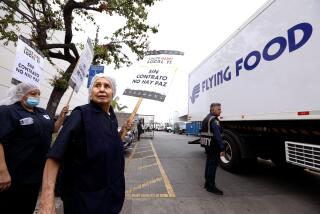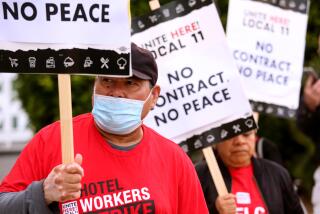Tapping Into the Senior Work Force : Companies Are Increasingly Seeking Retirement-Age Employees
NEW ORLEANS — Sylvia Corvo tired of retirement and went back to work when she was nearly 72. Now 80, she doesn’t plan to retire again unless poor health forces her--and she doesn’t think that’s likely any time soon.
She’s among a growing number of people returning to work or staying on the job after they turn 65. And Corvo, one of two Travelers Insurance Co. retirees who run a 700-person job bank, says many return for the same reason she did.
“I had been retired for seven years, and I woke up very bored one day and thought I ought to do something. I thought maybe I’d take some courses.”
But that day’s mail brought a letter from Travelers, where she had worked as an executive secretary and spent nine years running the suggestion plan. The company was collecting names of retired workers who might want to return for part-time or occasional work. Was she interested?
She has worked at the job bank Thursdays, Fridays and alternate Wednesdays ever since, keeping track of who is available, their skills, and what jobs need to be filled. “We’re very proud of our job bank. . . . And we save the company about a million dollars a year. That’s not bad.”
Seniors Widely Sought
Travelers isn’t the only company seeking out workers who once would have been considered over the hill. McDonald’s prints applications for “McMasters” on its tray liners. Day’s Inns of America Inc. held a Senior Power job fair in May that attracted 634 companies and 5,000 older people in 26 states. Polaroid Corp. offers gradual retirement for those who want to continue part time.
Companies are hiring or retraining older workers to stave off an impending labor shortage as baby boomers age.
“The United States is ahead of Europe in having the elements of such programs,” said Peter Plett, an International Labor Organization employee who is studying programs for older workers in North America and Europe.
“European business is still focusing on younger workers. . . . But Europeans will have to face a change from this youth wave in the next few years,” Plett said at a National Council on the Aging seminar earlier this year.
“There is really no choice. If we’re going to increase productivity and meet the needs of an aging work force, we’re going to have to totally change the concept of retirement,” said Daniel E. Knowles, vice president for human resources and planning at Grumman Aerospace Corp.
Labor Market Tightens
The nation’s average age is rising as the baby boomers get older and medical advances extend life expectancy. Meanwhile, the labor market has gotten tighter, said Philip Rones of the Bureau of Labor Standards.
“We have 3 million fewer younger workers than we did 10 years ago. We’re in the middle of the nation’s longest peacetime expansion. Unemployment is at a 15-year low,” Rones said.
The dearth of teen-agers coupled with a tight labor market has prompted McDonald’s to look for older people to work as everything from burger-flippers to managers for its fast-food restaurants. Thirty percent of American men aged 65 and older held part-time jobs in 1960; by 1986 that had risen to 48%. For women, the increase was from 43% to 61%.
“We recruit from our customers,” said Stanley Stein, a senior vice president at the Oak Brook, Ill.-based company. McDonald’s says older workers can set their hours and won’t work enough to lose Social Security benefits.
That possible loss of Social Security or pensions is one of the biggest obstacles to keeping older workers. Those 65 to 70 can make $8,800 this year and not lose any benefits. Under 65, it’s $6,480. Generally, $1 in benefits is lost for each $2 earned over the limit. At 70, earnings don’t affect benefits.
Restrictions Were Modified
When Travelers set up its job bank in 1981, it had to change restrictions that kept workers from collecting pensions if they kept working, said Harold Johnson, who was the company’s personnel director at the time.
“We can only work 960 hours a year. That’s approximately six months,” Corvo said. Some people fill in for those on sick leave or vacation; others work regularly one, two or three days a week. A few work full time, six months at a stretch, then take six months off. All are classified as temporary workers and paid the midpoint for each job’s salary.
More to Read
Inside the business of entertainment
The Wide Shot brings you news, analysis and insights on everything from streaming wars to production — and what it all means for the future.
You may occasionally receive promotional content from the Los Angeles Times.










